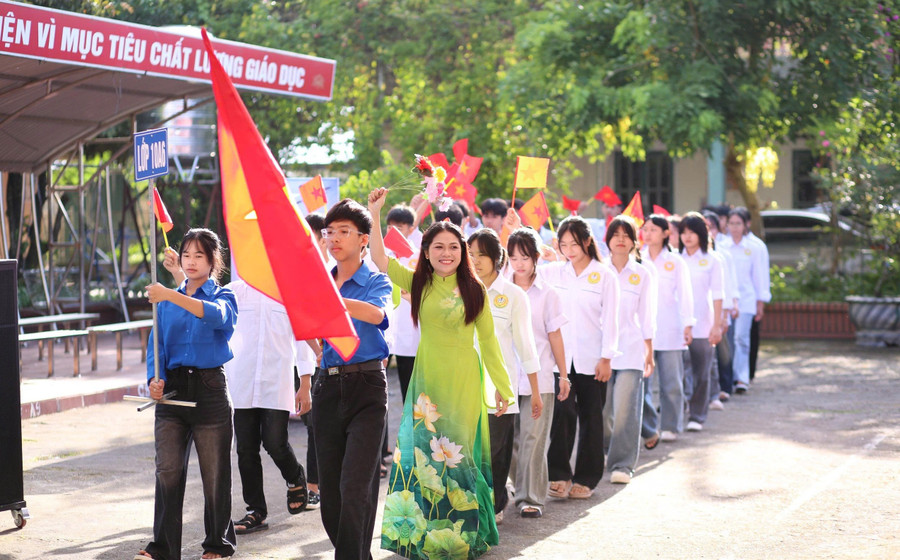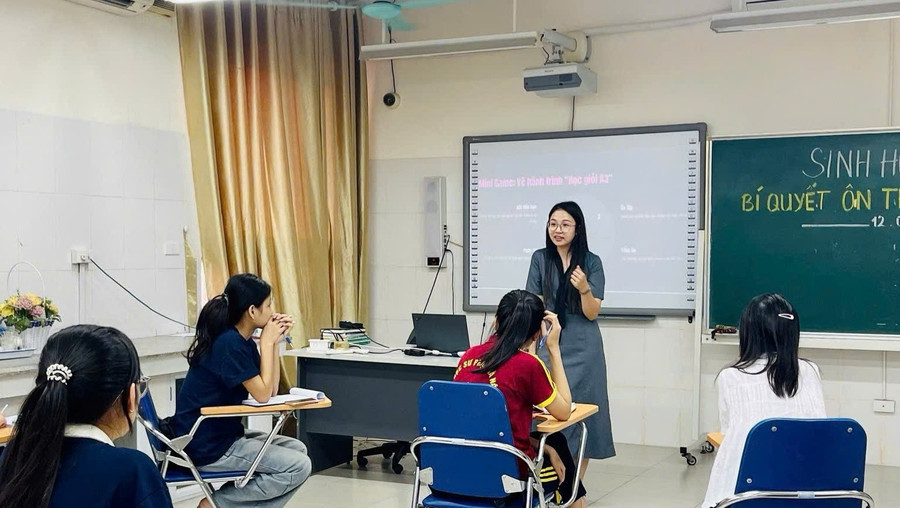This goal both demonstrates strategic vision and opens up the need for profound innovation so that education truly becomes a key driving force for national development.
Competitive advantage
Affirming that this goal is both groundbreaking and challenging, Dr. Nguyen Van Cuong (Potsdam University, Germany) said that Vietnam has the basis to realize it. During the renovation process, our country's education has achieved many remarkable achievements, especially since 2000 with a series of projects implemented at all levels of education.
General education has recorded high rankings in many international surveys, while the economy has maintained a rapid growth rate, forecast to continue to thrive and move towards the goal of becoming a high-income country by 2045. The Vietnamese tradition of studiousness and respect for education, combined with the Party's groundbreaking policies and directions in Resolution 71, are important driving forces to turn educational aspirations into reality.
According to Dr. Pham Van Gieng, Vice Principal of the Secondary and High School of Pedagogy (under Hanoi National University of Education 2), the goal of bringing Vietnam into the group of 20 countries with modern, equitable and quality education demonstrates the strong political determination of the Party and State, and is consistent with the aspiration to build a strong country in the mid-21st century.
The practical achievements in universalization, improving the quality of the team and innovating the program are the foundation for believing in the feasibility. This is also an inevitable trend when education becomes a driving force for national competitiveness. “If we miss this golden opportunity, we will fall behind in the knowledge era. I believe that Vietnam will achieve its goals if we maintain high political determination and receive consensus from the whole society,” Dr. Pham Van Gieng emphasized.
Also optimistic about the prospects of Vietnam's education, Mr. Ngo Huy Tam - education expert, Master of Curriculum Design, University of Houston (USA) - commented that, looking at the global picture, Vietnam's education has created bright spots, becoming a solid foundation for belief in big goals. In some criteria, Vietnam not only surpasses many developing countries but also approaches, even equals, some developed countries.
One of the outstanding strengths is the outstanding academic performance of Vietnamese students on international rankings. According to the PISA 2022 results, Vietnamese students' Math scores are close to the OECD average, while Reading and Science scores, although lower than the OECD average, are still far above the average of developing countries.
Notably, the percentage of students achieving the minimum level (Level 2 or higher) in all three subjects: Mathematics (72%), Reading (77%) and Science (79%) is higher than the OECD average. This achievement is further confirmed by the SEA-PLM 2019 Program, when Vietnamese primary school students ranked first in all three surveyed competencies: Reading, Writing and Mathematics.
Vietnam’s educational success is all the more remarkable in the context of its modest economic situation. A report by The Economist shows that Vietnamese students not only outperform Malaysia and Thailand, but also score higher than students in much richer countries such as the UK and Canada.
Meanwhile, according to the World Bank, Vietnam’s GDP per capita in 2024 will only reach $4,717, placing it in the lower middle-income group. The gap between limited economic potential and outstanding educational achievements creates a “positive paradox”, proving that the quality of education does not depend solely on finance.
“Vietnam has found more effective levers than money: a tight management mechanism, family support and cultural values that value learning. These non-economic factors become special 'competitive advantages', helping the education system achieve high efficiency even in conditions of limited resources,” said Mr. Ngo Huy Tam.

Challenges go hand in hand with opportunities
Despite its many advantages, Vietnam’s education system on its journey towards the top 20 countries in the world still faces many obstacles. The biggest challenge, according to Dr. Nguyen Van Cuong, is the quality of the staff, especially university lecturers, and the facilities of educational institutions. Currently, some of Vietnam’s leading universities have become centers of scientific research.
However, across the system, the qualifications of lecturers and the capacity of schools are still significantly behind the criteria of becoming world-leading universities and centers of research and technology transfer.
Along with that, although investment in facilities has been focused in recent years, many schools still lack equipment, facilities for practice, experiments and scientific research. This makes the connection between theory and practice not optimally effective and the principle of "learning by doing" has not really been implemented synchronously.
Dr. Pham Van Gieng also pointed out institutional, financial and human resource challenges. Mechanisms and policies need to be open enough to encourage innovation and promote autonomy. Financial resources must be invested in a focused, sustainable and long-term manner. Human resources, especially teachers, need to be treated fairly and continuously trained and improved in capacity.
Looking at countries like China, South Korea or Singapore, we can see that they invest heavily in education, and at the same time build a consistent mechanism for developing talent. Compared to them, Vietnam not only has to solve the problem of limited resources but also needs to design more flexible institutions if it wants to achieve real breakthroughs.
Mr. Ngo Huy Tam commented that the current success of Vietnamese education is mainly based on the tradition of a learning society, individual efforts and dedication of teachers. However, the system still lacks cohesion and does not operate effectively compared to its potential.
The objectives of Resolution 71 require profound and comprehensive changes in thinking, management models and resources, especially when the current education system still has many shortcomings. Access to education is uneven, facilities and teaching staff do not meet requirements, along with long-term consequences such as "achievement disease".
The main barriers include mindset and culture, human resource and infrastructure challenges, of which the teaching staff remains a major bottleneck. Although many important policies and guidelines have been issued, the process of institutionalization and completion of the legal framework for implementation remains slow and inconsistent.

The decisive factor is people
Dr. Pham Van Gieng affirmed that human resources are the key factor for Vietnam to realize the goals in Resolution 71. Any reform, facilities or technology are only meaningful when operated by a team of dedicated and professional managers and educators, and at the same time, are provided with conditions for long-term career development.
“The Pedagogical Secondary and High School is building a modern learning environment, directly connected to Hanoi Pedagogical University 2, where each teacher is both a teacher and a learner, constantly training to accompany students. Investing in people is the shortest way to help Vietnam reach its top educational goals,” Dr. Pham Van Gieng shared.
Resolution 71 has set out comprehensive viewpoints, tasks and solutions to realize the goal of educational development. Dr. Nguyen Van Cuong (Potsdam University, Germany) pointed out some key factors.
First of all, it is necessary to manage and improve the quality of the teaching staff, along with strengthening the educational facilities and equipment. There is a need for breakthrough and synchronous policies from training, fostering to treatment and use of human resources. Notably, the policy of increasing preferential allowances for preschool and primary school teachers stated in Resolution 71 is considered an important step forward, helping to motivate and encourage the staff to feel secure in their long-term commitment to the profession.
The second factor is to promote the autonomy of educational institutions and teaching staff, especially at the university level. Empowering and creating conditions for teachers, lecturers and schools to maximize their responsibilities will help effectively implement the goals of teaching and scientific research.
In addition, it is necessary to ensure a close connection between the development of education and training with science, technology and socio-economics. Education cannot be separated from science and technology or socio-economics; on the contrary, the development of education is the foundation for promoting science, technology and socio-economics.
Finally, and most importantly, is the renewal of awareness, specifically educational thinking. The view that “education and training determine the future of the nation” affirms that education is the top national policy. This awareness needs to be thoroughly understood and clearly demonstrated in investment policies. Investing in education is not only for social welfare, but also for development, which is decisive for the future of the country.
Regarding educational awareness and thinking, Resolution 71 emphasizes the views on educational goals, principles and methods. The Resolution continues the goal of building a comprehensively developed Vietnamese person, based on the educational principles that were formed since the early days of the nation's founding.
Accordingly, education must ensure harmony between universality and eliteness, between comprehensiveness and specialization, between national identity and global standards. Develop education based on cultural foundations and traditional values, while absorbing the quintessence of humanity, aiming to train Vietnamese citizens to become global citizens.
Resolution 71 also affirms the fundamental role of preschool and general education in shaping personality, developing qualities and capacities of learners, continuing the spirit of Resolution 29-NQ/TW. Dr. Nguyen Van Cuong commented: “Resolution 71 does not replace but inherits and continues previous resolutions, while focusing on solving the most crucial issues. The full and creative implementation of the viewpoints, tasks and solutions set out in the Resolution is the guarantee to realize breakthrough educational development goals.”
The goal of bringing Vietnam’s education into the top 20 countries in the world by 2045, stated in Resolution 71, represents a great aspiration and at the same time an important “guiding star”. That goal reflects Vietnam’s belief and confidence in the context of international integration.
This is not just a symbolic number, but also becomes a strong driving force for comprehensive system innovation, affirming the decisive role of education in the future and destiny of the country. - Mr. Ngo Huy Tam - Master of Curriculum Design, University of Houston (USA)
Source: https://giaoducthoidai.vn/khat-vong-dua-giao-duc-viet-nam-vao-top-20-the-gioi-post750090.html



![[Photo] High-ranking delegation of the Russian State Duma visits President Ho Chi Minh's Mausoleum](https://vphoto.vietnam.vn/thumb/1200x675/vietnam/resource/IMAGE/2025/9/28/c6dfd505d79b460a93752e48882e8f7e)
![[Photo] The 4th meeting of the Inter-Parliamentary Cooperation Committee between the National Assembly of Vietnam and the State Duma of Russia](https://vphoto.vietnam.vn/thumb/1200x675/vietnam/resource/IMAGE/2025/9/28/9f9e84a38675449aa9c08b391e153183)
![[Photo] Joy on the new Phong Chau bridge](https://vphoto.vietnam.vn/thumb/1200x675/vietnam/resource/IMAGE/2025/9/28/b00322b29c8043fbb8b6844fdd6c78ea)




























































































Comment (0)